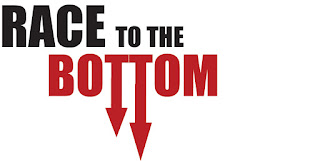 |
| Kali |
Check out the first article about Samsung/HP, here.
Samsung, recognizing print’s demise, ejects 6,000 employees and 6,500 patents - HP, Inc., like the family dog, sniffs up the crumbs. Todd Pike looks to be the smartest guy in the room.
Just three years after marching into the world of print and boldly pronouncing, "We're poised to lead a paradigm shift. We feel the world of printing is changing.”, the Korean chip maker waves the white flag, retreating to the fiery world of cellphones and silicon.
HP is buying Samsung's 'formidable' print/copy apparatus. It wasn't more than five years ago, that Samsung built a copier that worked. No really, I attended the roll-out in Jersey. A couple of new qualities they pitched were aligned output vs. skewed and variable-sized dots.
Stunning.
So now, the questions begin:
- What does this mean for the industry? Not much.
- Is this bad news for the Japanese OEMs? Of course.
- How does Canon come out of this? Like Oliver Twist, "Please sir..."
- Who is the big winner? Mother Blue, Kali, goddess of destruction.
- "HP's acquisition of Samsung gives them the opportunity to disrupt and truly innovate in this space at a time when most other OEMs are struggling. It's a real Game Changer!!!" - LinkedIn
- "This will shake things up a bit!!" - LinkedIn
- "HP to acquire Samsung's Print business is big news and will further enable our managed services business. We are driving disruptive change by bringing value to our clients." - HP
Not disruptive; turbulent.
HP shelled out less for Samsung than Ricoh for RiKON and may spend half as much on marketing into A3. Regardless of what happens on the OEM side of life, no degree of consolidation, no merger or acquisition, is going to entice customers into generating more 'clicks'.
 This is War. HP Inc. is maneuvering to be the last standing.
This is War. HP Inc. is maneuvering to be the last standing.Today, Monday, September 12, 2016, you are witnessing the beginning of the greatest campaign in our slight history. HP Inc.'s marketing war chest is huge and they're not doubling down on print, the farm is on the line.
But what else can they do?
In The War for Marks on Paper, HP Prevails.
There should be no doubt, that HP Inc. is in it to win it. Even with the decline, the last person selling buggy whips is still the only one selling buggy whips.
With the infrastructure and money to put service trucks into every major market in the U.S., HP Inc. looks like a mega-dealer.
Think about that.
 Supplies and services direct from the OEM.
Supplies and services direct from the OEM. Every service manager should be shaking in their boots at the prospect of HP Inc. riding into their town. And now, HP Inc. has a value proposition that includes A3.
This is not the same HP that purchased Palm and Compaq. These aren't the folks who clustered Hawk or propped Edgeline as the next coming, only to let it fail. No.
HP Inc. is the real deal; they've got a plan, money, and can reach from the F100 boardrooms to the SMB kitchen tables. The
But enough about print. Print is not the end-all and HP Inc. is not infallible - how can you differentiate yourself from the big MpS players?
Don't sell MpS.
Instead, offer IT Lifecycle Management. If you can sell copiers or managed services, I know IT Directors will take you more seriously when you suggest helping them manage their IT assets instead of "lowering print costs by 30%".















